Discoveries in biology keep pouring in that confirm biological functions are best described by engineering principles. A prime example is the recent description of a sophisticated control system in flowering plants that regulates their stem cells. A biological design theory expects to uncover elements in biological systems that would correspond to human-designed systems performing similar functions. Government funded research conducted by Zachary B. Lippman at Cold Spring Harbor Laboratory in New York identified mechanisms that confer “redundancy” to critical genetic control systems.1 Redundancy is an important engineering principle built into designs that enables something to maintain its function when being stressed.
Discoveries in biology keep pouring in that confirm biological functions are best described by engineering principles. ![]()
Cells responsible for growth in roots, stems, leaves, and flowers all begin as stem cells. (Note: Plant stem cells don’t exclusively grow into physical stems.) Growth occurs in the apices (tips) of stems and roots in stem-cell clusters known as meristems. Stem cells have the potential to develop into different kinds of cells, but both their differentiation and proliferation must be highly regulated or the result can be a disorganized mess. In Figure 1, Lippman produced some remarkable examples in tomato plants highlighting why control systems must tightly regulate stem cells by showing what happens when the system’s function becomes disrupted through mutations.
In a press release from Cold Spring Harbor Laboratories, Lippman emphasized the critical nature of stem cell control systems, saying, “Those players are critical for ensuring a plant has the right number of stem cells throughout life, and we discovered there are backup systems that kick in when these players are compromised through chance mutations.”2
Lippman’s research on Arabidopsis, corn, rice, and tomatoes underscores two important findings: 1) a matching “core genetic circuitry [is] found in all flowering plants” that he claims is “a deeply conserved stem cell circuit,” and 2) compensatory “backup systems” provide redundancy for the plant by “buffering” results—literally saving the information—if the core stem cell circuit is damaged. While all plants use the same core genetic circuit, “the genetic backup systems can vary drastically from plant to plant.”
Lippman and his colleague, David Jackson, believe that describing the diversity of these backup systems was their most important discovery. This led to their research paper being titled, “Evolution of buffering in a genetic circuit controlling plant stem cell proliferation.”1 Jackson says, “We were surprised to see such big differences but in retrospect it reveals the power of evolution in finding novel ways to protect critical developmental circuits.”2
Lippman and Jackson’s innovative experiment revealed some impressive systems. But when the interpretation of their findings is squeezed into evolutionary theory, so much imagination is integrated into their explanations that their plausibility is akin to that of a “just-so” story.
How do the researchers know the genetic circuits are deeply conserved? For them, it’s because they are all similar.
How do they know that these buffering systems evolved? Because they are drastically different.
How do they explain why “for 150 million years” the core circuits somehow escaped radical mutational changes, but in sharp contrast, the buffering systems in the same plants mutated wildly all around them? They chalk that feat up to “the power of evolution”…an explanation akin to magic. This shows frustratingly fickle characteristic of selectionism. In this case, selection causes drastic system variation—except when it keeps them quite unchanged. This characteristic was previously documented with many similar cases.3
But there’s an alternative way to interpret these experimental observations more precisely. It uses a framework that expects rapid and targeted responses, includes every system element, and doesn’t appeal to the mystical “power of evolution.” ICR is developing a theory of biological design as a more scientific approach to selectionism.4 One major assumption is that biological functions are far more suitably explained by engineering principles. The way in which stem cell control and genetic backup systems produce redundancy is evidence supporting that assumption. These control systems may also play a role in adaptive mechanisms, since, “function[ing] both to buffer stem cell homeostasis [a state of balance] and provide developmental flexibility.”
Innate control systems aren’t only essential to all dynamic entities, they are a hallmark of sophisticated engineering—especially the back-up redundancy systems. The myriads of phenomenally complex control and backup systems are evidence of the astounding creative genius of nature’s Creator, the Lord Jesus Christ.
References
1. Rodriguez-Leal, D. et al. 2019. Evolution of buffering in a genetic circuit controlling plant stem cell proliferation. Nature Genetics. 51: 786-792.
2. Stallard, B. To protect stem cells, plants have diverse genetic backup plans. Cold Spring Harbor Laboratory. Posted on cshl.edu on April 15, 2019, accessed May 24, 2019.
3. Coppedge, D. 2018. Darwinians Cannot Agree on What Natural Selection Is. Creation Evolution Headlines. posted on crev.info on April 2, 2018, accessed on May 10, 2019.
4. Guliuzza, R. J. 2018. Engineered Adaptability: Adaptive Changes Are Purposeful, Not Random. Acts & Facts. 47 (6): 17-19.
*Randy Guliuzza is ICR’s National Representative. He earned his Doctor of Medicine from the University of Minnesota, his Master of Public Health from Harvard University, and served in the U.S. Air Force as 28th Bomb Wing Flight Surgeon and Chief of Aerospace Medicine. Dr. Guliuzza is also a registered Professional Engineer.
















